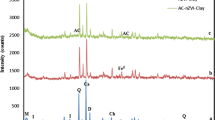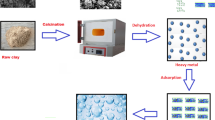Abstract
In this study, it was aimed to remove Cu(II) ions from the aqueous solutions by a biopolymer-clay nanocomposite (BCN) adsorbent. For this, the effects of some parameters, such as pH (pH 1–6), contact time (5–1440 min), the amount of adsorbent (0.5–3 g/L) and temperature (25–35 °C) were optimized. It was found that the adsorption became the most efficient by increasing the contact time and 99.74% removal efficiency for Cu(II) was achieved under the optimum conditions (pH 3; contact time 1440 min; adsorbent amount 1 g/L; 25 °C). Moreover, the adsorption data were modelled by Langmuir, Freundlich and Temkin adsorption isotherms and Langmuir adsorption was found to be the most appropriate adsorption isotherm model for Cu(II). The maximum adsorption capacity (qm) of biopolymer-clay nanocomposite adsorbent was found to be 214.28 mg/g for Cu(II). Furthermore, the pseudo-second-order reaction kinetic model was found to be the most suitable kinetic model for Cu(II) adsorption. The desorption efficiency from BCN surface was found to be 99.36% using 2 mol/L HNO3. The results revealed that BCN can be considered as effective, economic, and alternative adsorbent for Cu(II) removal based on the both 99.74% of removal efficiency and 214.28 mg/g of adsorption capacity and all experiments were carried out at least three times with a RSD values of 4%. Based on reusability of the adsorbent, it was seen that there was a slight decrease in the adsorption efficiencies in the third cycle but then adsorption decreased and reached 67% in the fourth cycle.
Graphical abstract




Similar content being viewed by others
References
Ahluwalia SS, Goyal D (2007) Microbial and plant derived biomass for removal of heavy metals from wastewater. Bioresour Technol 98(12):2243–2257
Srivastav AL, Patel N, Prajapati UB, Chaudhary VK (2021) In: Madhav S and Singh P (eds) Groundwater Geochemistry Pollution and Remediation Methods, 1st edn. Wiley Blackwell, New Jersey
Cheng M, Yao C, Su Y, Liu J, Xu L, Bu J et al (2022) Cyclodextrin modified graphene membrane for highly selective adsorption of organic dyes and copper (II) ions. Eng Sci 18:299–307
Sivamani S, Prasad BS, Nithya K, Sivarajasekar N, Hosseini-Bandegharaei A (2022) Back-propagation neural network: box-Behnken design modelling for optimization of copper adsorption on orange zest biochar. Int J Environ Sci Technol 19(5):4321–4336
Li Y, Mu D, Wu HQ, Tan DD, Liu XH, Sun J, Ji ZY (2022) Derivation of copper water quality criteria in the Bohai Sea of China considering the effects of multiple environmental factors on copper toxicity. Environ Pollut 308:119666
Al-Sareji OJ, Abdulredha M, Mubarak HA, Grmasha RA, Alnowaishry A, Kot P et al (2021) Copper removal from water using carbonized sawdust. In: fIOP conference series: materials science and engineering, vol 1058. IOP Publishing, Bristol, p 012015
Chérif I, Mbarek F, Majdoub FE, Smaoui S, Elhadef K, Chaari M et al (2022) ZnO nanoparticles as an antibacterial agent against foodborne pathogens and adsorbent for the removal of Congo red dye: effect of heating time. Reac Kinet Mech Cat 135:2719–2734
Lansari I, Benguella B, Kruchinina N, Nistratov A (2022) The removal of acid green 4G and anthraquinone orange from aqueous solution using adsorption on activated carbon from human hair. Reac Kinet Mech Cat 135(2):987–998
Oprescu EE, Enascuta EC, Vasilievici G, Banu ND, Banu I (2022) Preparation of magnetic biochar for nitrate removal from aqueous solutions. Reac Kinet Mech Cat 135:2629–2642
Xu Y, Chen J, Chen R, Yu P, Guo S, Wang X (2019) Adsorption and reduction of chromium (VI) from aqueous solution using polypyrrole/calcium rectorite composite adsorbent. Water Res 160:148–157
Giannakas A, Pissanou M (2018) Chitosan/bentonite nanocomposites for wastewater treatment: a review. SF J Nanochem Nanotechnol 1(1):1010
Han H, Rafiq MK, Zhou T, Xu R, Mašek O, Li X (2019) A critical review of clay-based composites with enhanced adsorption performance for metal and organic pollutants. J Hazard Mater 369:780–796
Saheed IO, Da Oh W, Suah FBM (2021) Chitosan modifications for adsorption of pollutants–a review. J Hazard Mater 408:124889
Biswas S, Fatema J, Debnath T, Rashid TU (2021) Chitosan–clay composites for wastewater treatment: a state-of-the-art review. ACS ES&T Water 1(5):1055–1085
Mounir C, Ahlafi H, Aazza M, Moussout H, Mounir S (2021) Kinetics and Langmuir-Hinshelwood mechanism for the catalytic reduction of para-nitrophenol over Cu catalysts supported on chitin and chitosan biopolymers. Reac Kinet Mech Cat 134(1):285–302
Chang YS, Au PI, Mubarak NM, Khalid M, Jagadish P, Walvekar R, Abdullah EC (2020) Adsorption of Cu (II) and Ni (II) ions from wastewater onto bentonite and bentonite/GO composite. Environ Sci Pollut Res 27(26):33270–33296
Celik D, Yildiz M (2020) Activation conditions of bentonite supports over gold-based catalysts for production of lactic acid from glycerol. Reac Kinet Mech Cat 129(2):693–705
Guo J, Chen S, Liu L, Li B, Yang P, Zhang L, Feng Y (2012) Adsorption of dye from wastewater using chitosan–CTAB modified bentonites. J Colloid Interface Sci 382(1):61–66
Calagui MJC, Senoro DB, Kan CC, Salvacion JW, Futalan CM, Wan MW (2014) Adsorption of indium (III) ions from aqueous solution using chitosan-coated bentonite beads. J Hazard Mater 277:120–126
Krstić V, Urošević T, Pešovski B (2018) A review on adsorbents for treatment of water and wastewaters containing copper ions. Chem Eng Sci 192:273–287
Abollino O, Aceto M, Malandrino M, Sarzanini C, Mentasti E (2003) Adsorption of heavy metals on Na-montmorillonite. Effect of pH and organic substances. Water Res 37(7):1619–1627
Crini G (2005) Recent developments in polysaccharide-based materials used as adsorbents in wastewater treatment. Prog Polym Sci 30(1):38–70
Alinnor IJ (2007) Adsorption of heavy metal ions from aqueous solution by fly ash. Fuel 86(5–6):853–857
Siddiqui SH (2018) The removal of Cu2+, Ni2+ and methylene blue (MB) from aqueous solution using Luffa actangula carbon: kinetics, thermodynamic and isotherm and response methodology. Groundw Sustain Dev 6:141–149
Steenkamp GC, Keizer K, Neomagus HWJP, Krieg HM (2002) Copper (II) removal from polluted water with alumina/chitosan composite membranes. J Membr Sci 197(1–2):147–156
Zhang LM, Chen DQ (2002) An investigation of adsorption of lead (II) and copper (II) ions by water-insoluble starch graft copolymers. Colloids Surf A 205(3):231–236
Ngah WW, Endud CS, Mayanar R (2002) Removal of copper (II) ions from aqueous solution onto chitosan and cross-linked chitosan beads. React Funct Polym 50(2):181–190
Huang Y, Wu H, Shao T, Zhao X, Peng H, Gong Y, Wan H (2018) Enhanced copper adsorption by DTPA-chitosan/alginate composite beads: Mechanism and application in simulated electroplating wastewater. Chem Eng J 339:322–333
Shirsath DS, Shirivastava VS (2015) Adsorptive removal of heavy metals by magnetic nanoadsorbent: an equilibrium and thermodynamic study. Appl Nanosci 5(8):927–935
Xu J, Qu Z, Yan N, Zhao Y, Xu X, Li L (2016) Size-dependent nanocrystal sorbent for copper removal from water. Chem Eng J 284:565–570
Tyagi I, Gupta VK, Sadegh H, Ghoshekandi RS, Makhlouf AH (2017) Nanoparticles as adsorbent; a positive approach for removal of noxious metal ions: a review. Sci Technol Dev 34(3):195–214
Debnath S, Ray NR, Ghosh UC (2011) Characterization of agglomerated nanosized titanium (IV) oxide prepared by two pathways and their performance toward Cu (II) adsorption. Int J Green Nanotechnol 3(4):271–280
Tsai WC, de Luna MDG, Bermillo-Arriesgado HLP, Futalan CM, Colades JI, Wan MW (2016) Competitive fixed-bed adsorption of Pb (II), Cu (II), and Ni (II) from aqueous solution using chitosan-coated bentonite. Int J Polym Sci. https://doi.org/10.1155/2016/1608939
Gülpınar M (2021) Synthesis and characterization of biopolymer-clay nanocomposite material for food packaging applications. Master's Thesis, Burdur Mehmet Akif Ersoy University
Thany ZW, Ridha AM (2018) Use of chitosan impregnated modified bentonite as an adsorbent for remediation of oil spill from aqueous solution. Int J Eng Technol 7(4):4380–4387
Tong L, Liang T, Tian Y, Zhang Q, Pan Y (2022) Research progress on treatment of mine wastewater by bentonite composite. Arab J Geosci 15(8):1–23
Wang Y, Jiang Q, Cheng J, Pan Y, Yang G, Liu Y, Wang L, Leng Y, Tuo X (2021) Synthesis and characterization of CTAB-modified bentonite composites for the removal of Cs+. J Radioanal Nucl Chem 329(1):451–461
Futalan CM, Kan CC, Dalida ML, Hsien KJ, Pascua C, Wan MW (2011) Comparative and competitive adsorption of copper, lead, and nickel using chitosan immobilized on bentonite. Carbohydr Polym 83(2):528–536
Grisdanurak N, Akewaranugulsiri S, Futalan CM, Tsai WC, Kan CC, Hsu CW, Wan MW (2012) The study of copper adsorption from aqueous solution using crosslinked chitosan immobilized on bentonite. J Appl Polym Sci 125(S2):E132–E142
Ba K, He LL, Tang H, Gao JQ, Zhu SF, Li Y, Sun WN (2014) Use of Chitosan-modified bentonite for removal of Cu 2+, C l-and 2, 4-dichlorophenoxyacetic acid (2, 4-D) from aqueous solution. Kem Ind 63:253–258
Md Ariff NF, Hanafiah MAKM, Wan Ngah WS (2017) Adsorption of Cu (II) onto cross-linked chitosan coated bentonite beads: kinetic and isotherm studies. In: Key engineering materials, vol 753. Trans Tech Publications Ltd., Wollerau, pp 243–248
Author information
Authors and Affiliations
Corresponding author
Additional information
Publisher's Note
Springer Nature remains neutral with regard to jurisdictional claims in published maps and institutional affiliations.
Supplementary Information
Below is the link to the electronic supplementary material.
Rights and permissions
Springer Nature or its licensor (e.g. a society or other partner) holds exclusive rights to this article under a publishing agreement with the author(s) or other rightsholder(s); author self-archiving of the accepted manuscript version of this article is solely governed by the terms of such publishing agreement and applicable law.
About this article
Cite this article
Güney, B.C., Arslan, Y. Removal of Cu(II) by biopolymer-clay nanocomposite adsorbent. Reac Kinet Mech Cat 136, 433–448 (2023). https://doi.org/10.1007/s11144-022-02340-5
Received:
Accepted:
Published:
Issue Date:
DOI: https://doi.org/10.1007/s11144-022-02340-5




